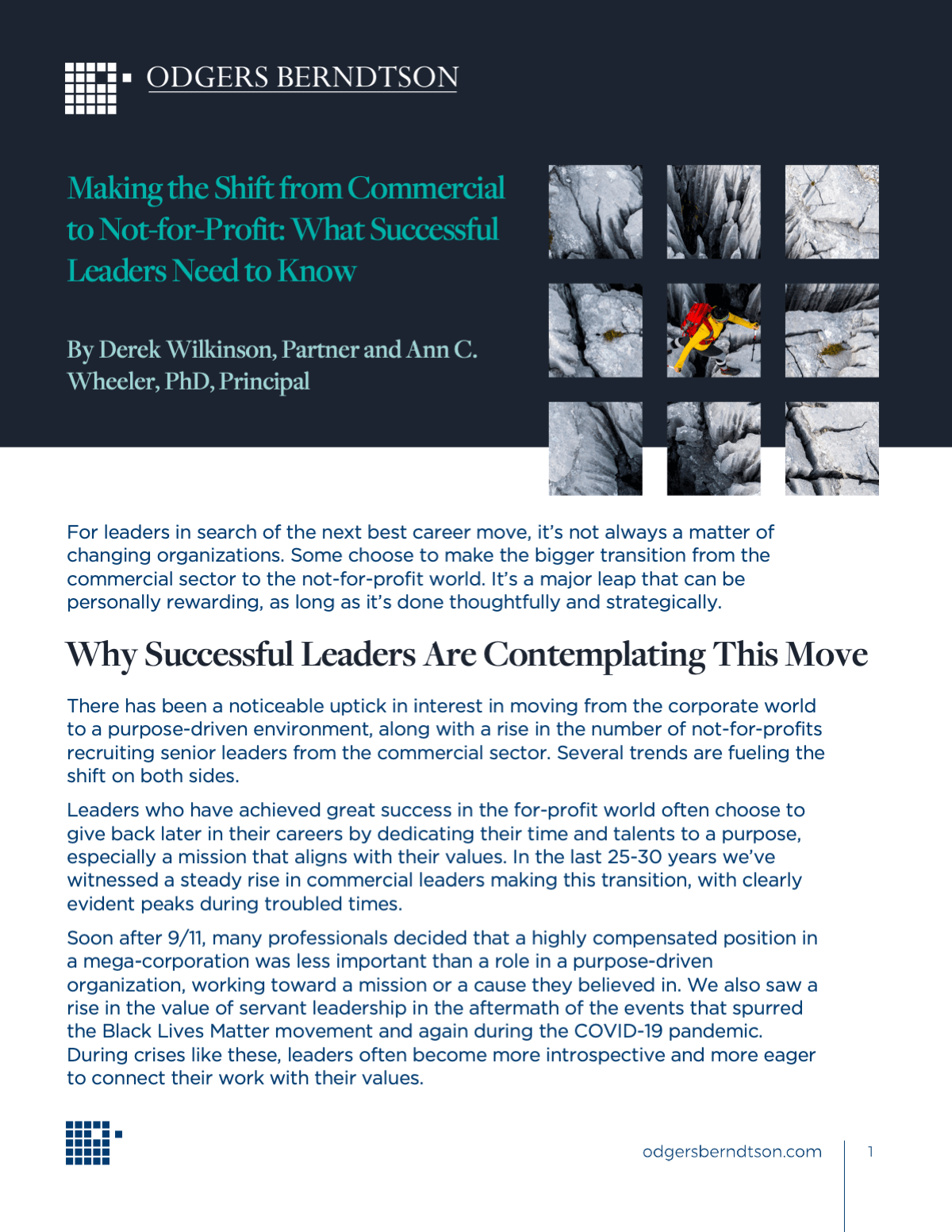For leaders in search of the next best career move, it’s not always a matter of changing organizations. Some choose to make the bigger transition from the commercial sector to the not-for-profit world. It’s a major leap that can be personally rewarding, as long as it’s done thoughtfully and strategically.
Why Successful Leaders Are Contemplating This Move
There has been a noticeable uptick in interest in moving from the corporate world to a purpose-driven environment, along with a rise in the number of not-for-profits recruiting senior leaders from the commercial sector. Several trends are fueling the shift on both sides.
Leaders who have achieved great success in the for-profit world often choose to give back later in their careers by dedicating their time and talents to a purpose, especially a mission that aligns with their values. In the last 25-30 years we’ve witnessed a steady rise in commercial leaders making this transition, with clearly evident peaks during troubled times.
Soon after 9/11, many professionals decided that a highly compensated position in a mega-corporation was less important than a role in a purpose-driven organization, working toward a mission or a cause they believed in. We also saw a rise in the value of servant leadership in the aftermath of the events that spurred the Black Lives Matter movement and again during the COVID-19 pandemic. During crises like these, leaders often become more introspective and more eager to connect their work with their values.
At the same time, many not-for-profits are choosing to recruit leaders from commercial organizations because their boards see value in bringing in a fresh perspective. When not-for-profits want to challenge the status quo, improve efficiency to generate a larger surplus from the same limited resources, or achieve ambitious growth goals, they often look to leaders from outside the confines of their industry for novel ideas and proven approaches. Some boards even view hiring a commercial leader as a critical first step in developing a succession plan that ensures the organization’s long-term viability.
The Challenges of Transitioning from Commercial to Not-for-Profit
While a commercial leader often proves a good match for a not-for-profit organization, several practical matters can make the transition trickier than changing companies within the same industry.
- Compensation model. In most cases, leaders aren’t compensated at the same level in a not-for-profit as they are in a commercial organization, particularly in the C-suite. Aside from base salary disparities, there may be fewer performance-based compensation opportunities. The specifics will vary by type of not-for-profit, with industry associations sometimes offering a higher pay scale than others in this sector.
- Governance model. In a not-for-profit, the board is typically composed of volunteers whose fiduciary responsibility is to ensure the organization has the resources to continue operating soundly. In a commercial organization, board members are typically compensated and have a fiduciary responsibility to turn a profit for the shareholders. Not-for-profit board members may be personally invested in the organization’s mission, while commercial board members might have greater emotional distance from the company’s objectives. While the board serves a similar function in both worlds, the governance model of a not-for-profit sometimes slows decision-making and reduces accountability at the board level. Leaders who work closely with the board will need to get acclimated to these dynamics.
- Unanticipated silos. When a leader makes the shift from a large corporation to a smaller not-for-profit, they might envision leaving the burden of functional silos behind. Unfortunately, that rarely happens. Employees are often drawn to a not-for-profit because they’re passionate about the cause. However, that passion has the potential to engender a belief that there is only one way to pursue the organization’s mission, which can create resistance to change, inhibit flexibility, and foster a myopic view. As a result, the same silos that plague a corporate environment can stonewall progress in a not-for-profit.
- Pace of change. Sometimes a not-for-profit hires a leader from the commercial world to effect change. But the incoming leader should be prepared for the possibility that change will occur more slowly than they expect. It will take a thoughtful, strategic approach to facilitate positive change at the right pace, without “breaking the dishes.” Focus groups and town halls can help solicit input and identify solutions, while getting employees excited about a new direction. Helping employees feel empowered to participate in positive change, and comfortable enough to fail fast, can break down barriers and speed the process toward an improved organization.
Preparing to Make the Leap
All that said, many professionals have made a successful shift from the corporate world to the not-for-profit environment, enjoying a satisfying career while producing strong results for their new employer. The following steps can help pave the way.
- Consider volunteering as a not-for-profit board member. Whether you target a specific organization or a type of mission you have an affinity for, participating on the board will give you visibility into the workings of a not-for-profit.
- Think about your end game. Even if you’ve held senior-level positions in the commercial world, you might not be tapped for the top role in a not-for-profit out of the gate. Are you willing to accept a different role initially, especially if the board unofficially names you the heir apparent to the current executive director? If you feel you could affect meaningful change and gain personal gratification at that level, it might prove a good stepping stone.
- Do your due diligence. Query different people at different points in your journey toward this decision, seeking out individuals you can trust to be candid and transparent. That might include a search partner with deep experience in this sector, colleagues from your professional network, or a board member at an organization you’re considering joining. A change of this magnitude requires M&A-level due diligence, so be prepared to ask a lot of probing questions. The more you learn, the less likely you’ll become unconsciously blinded by the organization’s mission, which is a very real risk. Maintaining objectivity can help you keep in mind that the mission and the organization are not synonymous.
Part 2 of this article series will explore best practices that not-for-profits can employ to maximize the value of hiring a leader from the commercial world.
The Leadership Advisory Practice at Odgers Berndtson helps organizations discover and develop leaders, strengthen value-creating teams, and prepare for what’s next. Learn how our highly experienced assessors and coaches can help you and your team make a positive impact on your organization and those around you.




